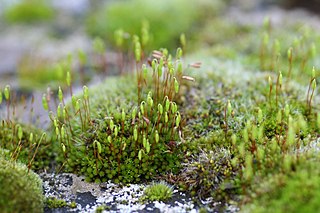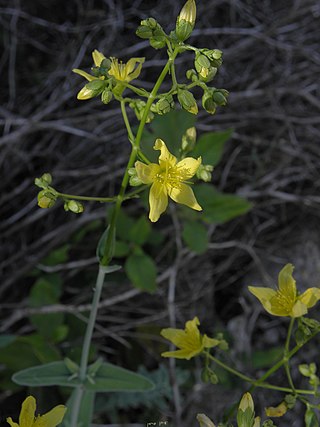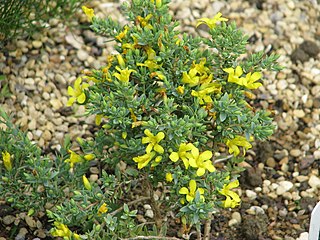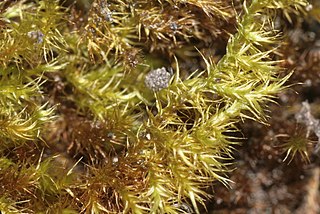
In zoological nomenclature, a type species is the species name with which the name of a genus or subgenus is considered to be permanently taxonomically associated, i.e., the species that contains the biological type specimen. A similar concept is used for suprageneric groups and called a type genus.

Stagnicola is a genus of air-breathing freshwater snails, aquatic pulmonate gastropod mollusks in the family Lymnaeidae, the pond snails.

Bryaceae is a family of mosses.

Ladislavella elodes, the marsh pondsnail, is a species of air-breathing freshwater snail, an aquatic pulmonate gastropod mollusc in the family Lymnaeidae, the pond snails.

Hypericum elodes, commonly known as marsh St John's-wort, is a species of flowering plant in the St. John's wort family Hypericaceae. It is native to Western Europe.

Amblystegiaceae is a family of mosses. It includes 20 to 30 genera with a total of up to 150 species. They occur nearly worldwide, growing in tropical, temperate, and subpolar regions.

Hypericum lanuginosum, or downy St. John's wort, is a perennial herb, a flowering plant in the St. John's wort family Hypericaceae.

Hypericum naudinianum is a perennial herb in the genus Hypericum, in the section Adenosepalum.
Hypericum pubescens is a perennial herb in the Hypericaceae family. It is in the section Adenosepalum.

Elodes is a genus of marsh beetles in the family Scirtidae. There are more than 60 described species in Elodes.

Adenotrias is a section of flowering plants in the family Hypericaceae. It is made up of Hypericum aciferum, H. aegypticum, and H. russeggeri. When it was first described, it was considered its own independent genus, but was later placed under Hypericum and demoted to a section. Its Latin name Adenotrias is made of the Greek prefix adeno- and the Latin word trias. Species in the section are shrubs up to 2 metres (6.6 ft) tall with smooth leaves and bark, and are the only species in Hypericum with heterostylous flowers. They are found around the Mediterranean coast, with H. aciferum restricted to the island of Crete and H. russeggeri present only in parts of Turkey and Syria. Plants of the section have a habitat among limestone and other calcareous rocks. While H. aegypticum has a wide and generally secure distribution, H. aciferum was evaluated as endangered several times since the 1980s, although it is now considered only vulnerable because it is protected in part by a plant micro-reserve near Agia Roumeli.

Hypericum aciferum is a species of flowering plant in the St John's wort family Hypericaceae. It is a small shrub endemic to the Greek island of Crete. H. aciferum grows in a mat on the ground and has twisting branches, needle-like leaves, and long golden petals. Its flowers are also heterostylous, which means that the species can exhibit one of two flower types on different plants. This trait is unique within the genus Hypericum to H. aciferum, H. russeggeri, and H. aegypticum, the three species in section Adenotrias.

Mniaceae is a moss family in the order Bryales.
Mittenia is a genus of haplolepideous mosses (Dicranidae) with a single species, Mittenia plumula, which is the sole representative of the family Mitteniaceae in the order Pottiales.
Campylium is a genus of mosses belonging to the family Amblystegiaceae.

Campylium polygamum is a species of moss belonging to the family Amblystegiaceae.
Campylium protensum is a species of moss belonging to the family Amblystegiaceae.

Anastrophyllaceae is a family of liverworts belonging to the order Jungermanniales.

Campylium chrysophyllum is a species of moss in the Amblystegiaceae family. It has a cosmopolitan distribution.














